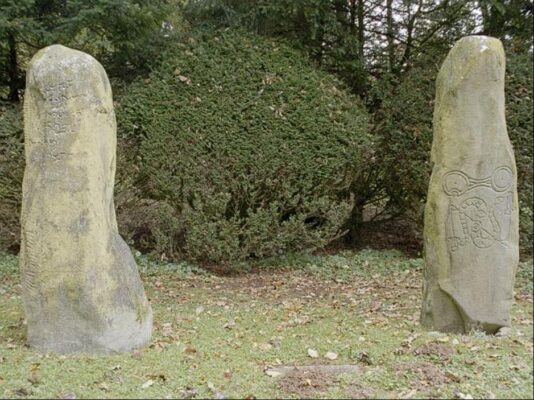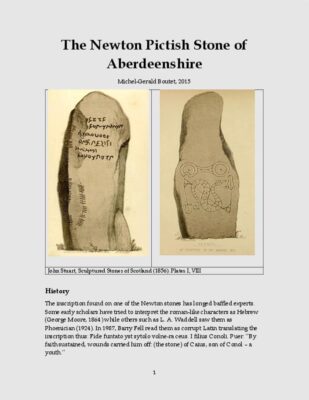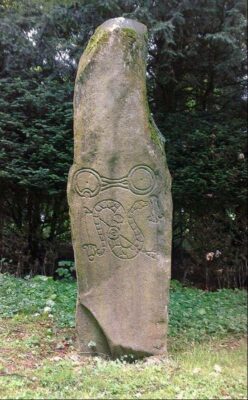The Newton Stone, an ancient pillar in Aberdeenshire, Scotland, presents a fascinating historical puzzle with its two inscriptions. While the Ogham inscription is largely understood, the second inscription remains an undeciphered mystery, captivating scholars and enthusiasts alike.
The Mystery of the Second Inscription
The second inscription on the Newton Stone has defied attempts at decipherment, sparking numerous theories and debates.
Unidentified Script
The script of the second inscription does not match any known alphabet, making it a unique and perplexing historical artifact.
- Unknown Alphabet:
- The inscription consists of six lines of text in a script that has no known parallels in any documented writing system.
- Its uniqueness has fueled speculation and debate among scholars.
- Decipherment Challenges:
- The lack of comparative texts and the script’s unfamiliar characters have made decipherment extremely challenging.
- The inscription remains an unsolved puzzle, defying conventional linguistic analysis.
- Enduring Enigma:
- Since its discovery in the 19th century, the inscription has remained an enduring enigma, attracting attention from researchers and enthusiasts.
- Its mystery continues to fascinate those interested in ancient scripts and lost languages.
Dismissed Theories
Early theories linking the inscription to exotic scripts like Phoenician or Greek have been largely dismissed due to lack of historical and archaeological evidence.

- Phoenician Connection:
- Early scholars speculated a connection to Phoenician scripts, but there is no evidence of Phoenician traders in Scotland.
- This theory has been widely rejected due to the absence of supporting evidence.
- Greek Connection:
- Similarly, theories suggesting a Greek origin have been dismissed due to the lack of historical or archaeological support.
- The absence of Greek settlements or trade routes in the region makes this theory implausible.
- Lack of Evidence:
- The absence of any historical or archaeological evidence supporting these exotic connections has led to their dismissal.
- Realistic theories have focused on local origins and more plausible scenarios.
Plausible Hypotheses
More realistic hypotheses suggest the inscription could be linked to the Picts or be a later hoax, reflecting the era’s fascination with ancient mysteries.
- Pictish Writing System:
- One plausible theory is that the inscription represents a lost writing system of the Picts, the pre-Scots inhabitants of Scotland.
- The Picts left behind numerous symbol stones, but no confirmed writing system, making this a tantalizing possibility.
- 19th-Century Hoax:
- Another theory suggests the inscription could be a 19th-century hoax, a product of the era’s obsession with ancient mysteries.
- This theory acknowledges the historical context and the prevalence of forgeries during that period.
- Symbol Stones Connection:
- The inscription’s potential connection to Pictish symbol stones has led to further research into their symbolic language.
- The search for patterns and connections between these artifacts continues.
The Newton Stone’s Lasting Significance
The Newton Stone’s undeciphered inscription continues to hold significant historical and cultural value, despite the lack of a definitive interpretation.
Undeciphered Legacy
The second inscription’s undeciphered nature adds to the stone’s mystique and historical significance.

- Unsolved Mystery:
- The inscription remains an unsolved mystery, adding to the allure of the Newton Stone.
- Its undeciphered status keeps it a subject of ongoing research and speculation.
- Historical Curiosity:
- The stone serves as a historical curiosity, attracting attention from researchers, historians, and enthusiasts.
- Its enigmatic inscription sparks imagination and curiosity.
- Cultural Symbol:
- The Newton Stone has become a symbol of Scotland’s ancient past and the mysteries it holds.
- It represents the challenges of interpreting ancient artifacts and lost civilizations.
Ongoing Research
Despite the lack of a definitive interpretation, research on the Newton Stone continues, driven by the hope of new discoveries.
- Potential Discoveries:
- The possibility of new discoveries or technological advancements keeps research on the inscription alive.
- Future findings could provide new insights into the script and its origins.
- Linguistic Analysis:
- Ongoing linguistic analysis and comparative studies continue to explore potential connections to other scripts and languages.
- Researchers use advanced techniques to uncover hidden patterns and clues.
- Archaeological Context:
- Further archaeological investigations in the surrounding area could provide additional context and clues about the inscription.
- Understanding the stone’s archaeological context is crucial for its interpretation.
Historical Value
The Newton Stone holds significant historical value, regardless of whether the second inscription is ever deciphered.

- Ancient Artifact:
- The stone itself is an ancient artifact, providing valuable insights into the history of Aberdeenshire and Scotland.
- Its physical presence connects us to the past.
- Ogham Inscription:
- The Ogham inscription provides valuable information about early medieval scripts and the languages of the time.
- Its deciphered content offers insights into the historical context of the stone.
- Symbolic Importance:
- The stone’s symbolic importance lies in its representation of the mysteries of the past and the enduring quest for knowledge.
- It serves as a reminder of the many unanswered questions that remain in history.
The Newton Stone’s second inscription remains a captivating enigma, a testament to the mysteries of the past. Its enduring allure lies in its undeciphered script, sparking curiosity and inspiring ongoing research into Scotland’s ancient history.

CÁC TIN KHÁC
Mary Walton: The Forgotten Inventor Who Helped Clean Up America’s Cities
Tomb of Queen Nefertari in the Valley of the Queens, Egypt
Discover the Hypostyle Hall of the Temple of Hathor at Dendera
Venus de Losange: Unveiling the Mystery of a 20,000-Year-Old Paleolithic Icon